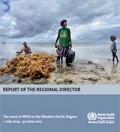Publications - Released in 2015
Member States in the WHO Western Pacific Region made significant gains over the past year in improving health outcomes and strengthening health systems. Communicable disease morbidity and mortality continued to decline, and noncommunicable diseases and their risk factors were more effectively addressed. Real progress occurred in the move towards universal health coverage, and the Region is now better equipped to handle threats posed by emerging infectious diseases, emergencies and disasters.
WHO reforms continued to focus on tailoring support to the specific needs and priorities of the 37 countries and areas that make up the Western Pacific Region. Often that meant going beyond traditional global and regional approaches to develop more localized initiatives.
WHO’s work, however, is far from complete. More needs to be done in fighting difficult diseases such as malaria and tuberculosis, as well as neglected tropical diseases. We must strengthen preparedness and better mitigate the risks associated with emergencies and disasters. Recent challenges, including the health impacts of climate change, also must be addressed if we are to achieve even better health outcomes.
This brief summary of achievements and challenges serves as an introduction to the work of WHO in the Western Pacific Region for the year that ended on 30 June 2015.
Downloads
Organizations
- WHO, Regional Office for the Western Pacific






